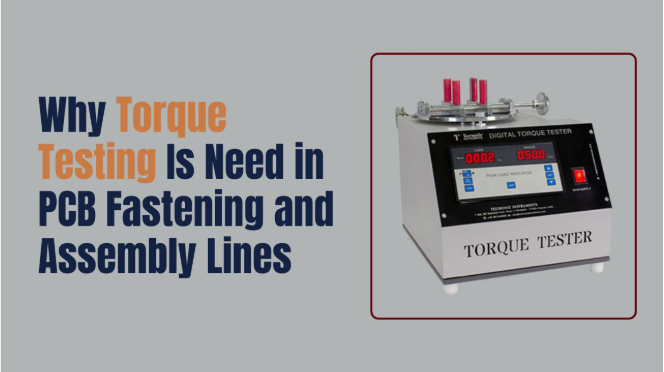In the constantly changing world of electronics production, accuracy is not an option. With printed circuit boards (PCBs) continually shrinking and becoming more densely packed with components, accurate fastening torque becomes an essential quality control factor. This is where torque testers come into play. From facilitating the best possible contact to avoiding microcracks and component failure, torque testing ensures the structural and functional stability of every PCB going down the production line.
Understanding the Torque Tester Principle
To truly enjoy its worth, it’s necessary to learn first about the torque tester principle. A torque tester is an instrument that’s used to gauge the twisting force (torque) exerted on fasteners like screws, bolts, or connectors. The torque tester principle is to measure the opposing force to turning — either during the tightening of the fastener (dynamic torque) or once the fastener is secured (static or residual torque).
Torque testers may be mechanical or digital, the latter having good precision, logging, and programmable threshold capabilities. During PCB assembly, torque testers assist in providing assurance that the torque put into use during fastening remains within strict tolerances—neither so tight as to hurt the PCB nor so loose as to weaken the connection.
Why Torque Testing Matters in PCB Assembly
1. Preventing PCB Damage
Excessive torquing of screws on a PCB may result in board warping, trace cracking, or even breakage. Considering PCBs are usually a matter of millimeters thick and loaded with delicate surface-mounted components, it is essential to have a torque tester to avoid excessive force during assembly.
2. Ensuring Stable Electrical Connections
PCBs are dependent upon secure and tight connections for high signal integrity and performance. The lack of appropriate fastener torque may result in loose parts that lead to voltage drops, weak connections, or even shorting. A torque tester guarantees all screws and all connections are secured to the perfect specification for secure conductivity.
3. Supporting Miniaturisation and High-Density Designs
Modern electronics call for more compact devices with increased functionality. That means small PCBs with sophisticated designs. Room for error dwindles in those conditions. Torque testers become necessary to cope with such tight tolerances so that reliable fastener performance can be ensured without compromising the board or nearby components.
4. Compliance with Industry Standards
The electronics manufacturing industry maintains rigorous standards such as IPC-A-610 and ISO 9001. In many cases, these standards need process validation as well as documentation, especially where critical fastening operations are concerned. A calibrated torque tester satisfies compliance by noting precise torque figures applied during the assembly process for traceability as well as auditing purposes.
5. Reducing Product Failures and Returns
Electronics manufacturers spend a lot of money on warranty claims, returns, and recalls—most of which are caused by assembly flaws. Applying a torque tester at the production line significantly minimizes such risks by guaranteeing each part is securely fastened. In mass production, this translates into tremendous savings and enhanced brand credibility.
How Torque Testers Are Integrated into Assembly Lines
Torque testing for PCB assembly can be applied in several stages:
- Manual Assembly Stations: Handheld torque testers are employed by operators to check torque value after fastening.
- Automated Assembly Lines: Torque-sensitive robotic screwdrivers apply and authenticate torque in real-time.
- Post-Assembly Inspection: Specialized torque testing stations inspect many finished boards to ensure process consistency.
These configurations not only confirm the torque applied but also save the data for every unit manufactured, giving it an added level of quality control.
Choosing the Right Torque Tester for PCB Assembly
When choosing a torque tester for use on PCBs, the following points should be taken into consideration:
- Accuracy: Choose an instrument that provides high-resolution torque measurement for low-torque operations.
- Size and Ergonomics: Small testers are a must in the confined spaces common in PCB environments.
- Data Logging Capabilities: Built-in memory and connectivity ensure torque data can be captured and recorded for analysis later.
- Calibration Support: See to it that the tester is easy to calibrate in order to ensure measurement accuracy over a period of time.
Certain premium versions also come equipped with programmable alerts as well as real-time feedback that notifies operators of misapplied torque beyond allowable specifications.
Conclusion
In PCB production, where reliability and accuracy of components are the top priority, torque testing is not a voluntary quality control measure—it is a requirement. Through the use of torque testing on assembly lines, producers can reduce defects by a huge margin, enhance product lifespan, and ensure compliance with regulations with confidence.
Knowing the torque tester principle and using the proper torque tester can make all the difference between good product quality and costly mistakes. For manufacturers seeking to implement precision torque testing products, Testronix provides high-quality torque testing tools for the electronics market. Offering reliable performance, easy-to-use interfaces, and data management functions, Testronix assists electronics producers in advancing their assembly operations and upholding world-class levels.

